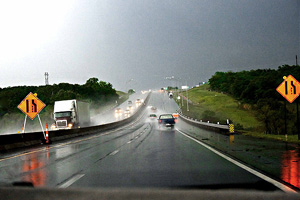Tolls Will Rise 17% in Oklahoma by 2019, Pending Court Case

The Oklahoma Turnpike Authority has voted to increase fees on the state’s toll roads by 12% on Jan. 1, with additional hikes of 2.5% set for 2018 and 2019.
For example, the toll to drive the Turner Turnpike from Oklahoma City to Tulsa would rise from $20 for a six-axle truck to $23.63 in 2019.
However, according to the Turnpike Authority, the rate hikes are on hold until a lawsuit challenging the use of toll revenue to finance the new construction of a new toll road in Oklahoma City and Tulsa is resolved. The case is being considered by the Oklahoma Supreme Court.
The new toll roads, including one that will connect interstates 40 and 44 near Oklahoma City in hopes of reducing traffic on the adjacent I-35, are part of a four-year transportation plan unveiled last year that is largely being financed by $900 million in bonds.
The Oklahoma Trucking Association is sanguine about the toll increases.
“Lane miles and bridges are very expensive,” said OTA Executive Director Jim Newport. “While we would all like to travel for free, the truth is infrastructure must be paid for one way or another. The governor and the Turnpike Authority have determined that for safety and reduced congestion, these projects need to move forward.”
Newport noted that the Oklahoma Turnpike Authority is highly rated by Fitch, Moody’s and Standard & Poor’s.
“This means Oklahomans can continue to have infrastructure investment in a fiscally responsible way,” Newport said. “While the toll will adjust upwards, the benefit to motorists is new, safe, less congested highways without further burden to the state Department of Transportation.”
ODOT spokeswoman Terri Angier concurred, saying, “If they weren’t building [those roads], it would just add to the huge amount of responsibility for DOT.”
That also has allowed ODT to focus on reducing the number of structurally deficient bridges in the state. ODOT said that 1,168 of Oklahoma’s approximately 6,800 bridges were in bad shape in 2004. Today, that total has been whittled to 321, thanks to a financial commitment from the Legislature that began after the 2002 accident on I-40 in Webbers Falls, where a barge hit a bridge and 14 people died. After $100 million was allocated for bridges in 2005, ODOT began receiving some general fund revenue in 2006.
“After decades of underfunding, [we were] given some of the resources to put towards infrastructure,” Angier said. “We chose to focus on structurally deficient bridges right after the Webbers Falls incident. Of the 59 bridges on the detour routes, almost every one of them was in terrible shape.”
Oklahoma’s 2017-2024 transportation plan encompasses nearly $6.4 billion in federal and state funds for 1,616 projects, including 824 highway bridge replacements or repairs — despite a cut of $123 million from this fiscal year’s expected budget for highways and bridges.
“We’re still in a lot better shape than we were in 2006,” Angier said. “Our state funds have almost doubled [since then]. Bridges will still be No. 1 until we finish the goal we set out to do by 2020: reducing the number that are structurally deficient to as close to zero as we can.”

